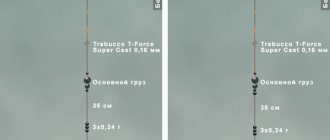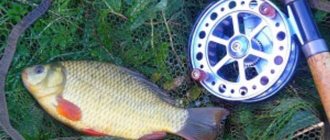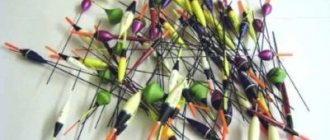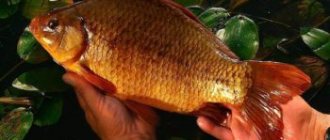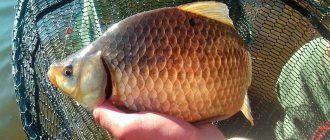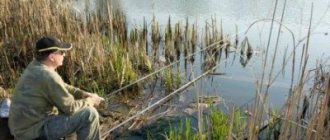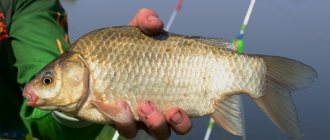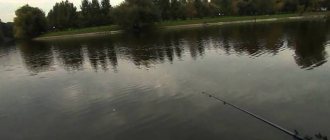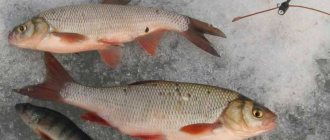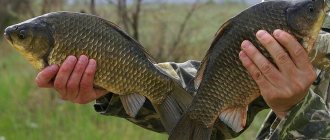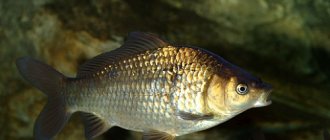Crucian carp - description
The name from Latin is “Carassius”. Its roots are lost in the old German word "Karas". Linguists are constantly debating about this origin of the ray-finned cyprinid order.
The habitat is very wide. It lives not only in Russia (the European part of the Russian Federation, the Far East, the waters of Siberia), northern Asia, some European countries, even the USA knows this fish quite well.
A large carcass with flattened barrels. The smooth shapes of the back form a semicircle. The fin on the back is large and tends towards the tail. The anal one has a difference, like many other species - a small notch. The sides of the crucian carp are equipped with a special sensitive “line” in the middle. With its help, he, like a locator, picks up the slightest external movements. This lateral “sensor” is a pore that is anatomically connected to the internal receptors of the body.
The head is small, the eyes are also small, but have dark expressive pupils. Mouth towards the top. The cavity contains one row of teeth and swallowing fangs.
The entire body is covered with large and smooth scales. The dimensions of an adult individual are 55-65 cm in length, weighing over 5 kg.
By nature, the carp order is characterized by an excellent sense of smell and an average life of 7 - 10 years. A separate subspecies can live up to 13 years.
Kinds
Based on shape, size, color of scales, and habitat, crucian carp fish are divided into many species.
Goldfish
The gray tint of the silver color is sometimes replaced by grey-green scales of the fish depending on the habitat. The 45 cm long species lives in fresh water for about 7-9 years. The weight of an adult crucian carp is up to 3.5 kg. Fresh river fish.
Externally, his body and head form a kind of sharp edge. The scales are very large. The dorsal fin is not convex at the end, but concave inward. This species previously lived even in the Pacific Ocean. Through Siberian water streams it entered European water bodies. Research has shown that the migration of crucian carp was accomplished artificially.
Females spawn together with males of other fish. Together with carp, bream, roach. This means that their fertilization occurs in the absence of male sperm. Then the crucian carp develops by laying eggs. At this spawning, only females produce fry.
Golden crucian carp
Fish with an elongated body. Covered with large scales of a golden hue. A brown or copper tint is visible. Individuals are larger than silver fish. They reach a length of 0.5 m. They are also ahead of the silver ones in terms of mass. On average they gain 5-6 kilos. Life activity is 13 years.
Body structure with a convex dorsal fin. The head of the golden one is unlike its other brothers. It's rounded. The belly is without the usual pigments. It lives mainly in swampy waters of lakes and coastal reed thickets.
Interestingly, golden crucian carp spend the winter individually. In a sleepy state, it buries itself in the bottom silt of the lake. In this position, all the cold sleeps. This allows the type to survive the cold even when the surface of the water is bound by an ice shell.
Scientists note that the depth of burrowing into the silt reaches 75 cm. The fish loves underwater vegetation. If the bottom of the lake is sandy and there is no silt provided by nature, the growth of the species is very slow.
Nautical
It bears the second name “Laskir”. Habitat: Azov and Black Seas. Rarely found in warmer seas. The fish differs significantly from its freshwater “brothers” in appearance. The “weasel” has a different way of life.
Caution and fear are in the first place for sea crucian throughout life. It is very easy for a novice fisherman to scare him off. The marine type has an oblong body. The sides are flat. The color is yellow, the belly shines with silver lighter than the body. A dark-colored spot near the tail feathers of the fish is the main sign of golden crucian carp.
Teeth in rows. First, the wide incisors. Afterwards - chewing.
The size of the individual is small. The most outstanding in length are up to 35 cm. The weight of crucian carp is less than that of river or lake “relatives”. Rarely exceed 1 kilo.
However, the seas are richer filled with living organisms than those of freshwater types. This means that sea crucian carp naturally receives some traits that allow it to live calmly in the salty world. The differences repel many predators when attacked. They are given sharp “rays” of the anal fin. Fish uses them as weapons in conflicts with other water inhabitants. For this reason, fishermen nicknamed the sea crucian “ruffy fish.”
Likes to be located at a small coastal distance. Inhabit rocks and hide in them. During calm periods, schools of weasel go into the sea, to the depths, but rarely move; the fish are mostly sedentary.
There are decorative subtypes of sea crucians (for aquariums). There are subclasses in the sea - “goldfish”, white Japanese, crucian carp mabuna. They are either not intended for fishing, or are very rare in habitat.
Choosing gear for catching crucian carp and features of use
Today there are really many variations of gear for catching crucian carp. But the most common, popular among fishermen, are the following:
- Float rod.
- Feeder.
- Donka.
- Rubber.
- Spring.
Tips for a fisherman: What kind of hook is needed to catch crucian carp - Answers for beginners
Let's take a closer look at them.
Float rod
This fishing rod is a combination of a rod, line with float, sinker and hook. For many anglers, this is the best option for catching crucian carp. You can fish this way both from a boat and from the shore.
The main requirement for a float rod, as for any crucian tackle, is high sensitivity, because crucian carp bites quite carefully, so you need to be able to hook it in time. The rod should be stiff so that you can hook the fish and prevent it from leaving. The float is light.
Feeder
Also a fairly common tackle. The whole essence of fishing comes down to the fact that with the help of a reel and a strong rod, the length of which varies quite greatly, a feeder with bait is cast. This attracts crucian carp, which, along with the food, grabs the baited hook.
When choosing, there are several points to consider:
- The rod should be of medium weight; options that are too long will not work.
- Feeders are suitable weighing from 50 to 80 grams, depending on whether you are fishing in currents or in standing water.
The feeder is used for casting over long distances and to depth. The feeder performs excellently on lakes and when fishing for large fish.
Donka
This fishing rod itself represents a fishing line with a load. Hooks are located on leashes above the load. The essence of fishing is as follows: the load is untwisted and thrown to the right place. In order to detect a bite, a bell alarm is used.
The optimal time for fishing with this method is cold, cloudy weather. At this time, the fish just goes to depth.
Rubber
This tackle has much in common with a regular donka. True, there is one additional element - an elastic band, which gave it its name. The elastic stretches when the fishing line attached to it is pulled out, and then returns back. This type of gear is used in various bodies of water. Multiple hooks allow you to try different baits.
Spring
This is a bottom tackle that has a spring-shaped feeder. Leashes are tied to the spring itself. The spring itself is first filled with bait. And the hooks are slightly recessed into it. When the fish eats the bait, it will grab the hooks.
This is a fairly catchy tackle; it can catch quite large fish.
For crucian carp fishing, three types of bait are used:
Habitats of crucian carp
Vast territories distinguish its species from other types. Give the population some advantages. Silver and golden crucian carp love clean fresh rivers, lakes, and ponds. But they can also feel comfortable in marshy areas of water. Where crucian carp still cannot live is in the water of mountain lakes or rivers.
Human labor gave crucian carp life and free development in the waters of Europe. In the East - Poland, Hungary, Romania. In Western - Germany, Italy, Portugal. There is fish in the country of Foggy Albion - Great Britain.
Habitat range: central Russian Federation, Far East, Siberia. CIS countries boast of the presence of fish - Belarus, Kazakhstan, Ukraine.
Crucian carp is found in Mongolia, China, Korea and Japan. In Pakistan, Thailand. In the USA and India. The family covers fresh and salt waters of almost the entire world.
Due to their wild endurance, the habitat of crucian carp is enormous. Some species survive changes in water temperature and difficult wintering. They burrow into the bottom to a depth of 70 cm.
Scientists observed the family of crucian carp, their habitat, and behavior. Based on the following conclusions were drawn:
- the reservoir has a vast bottom with silt - the crucian carp population is growing;
- with silt at the bottom - suspended animation - survival in winter.
The habitat allows many fishermen not only to enjoy the process of catching crucian carp, but to leave fishing with their catch.
Habitat in fresh waters in swampy coastal zones. Where the water warms up faster, there is vegetation and a muddy bottom. It is impossible to find crucian carp at depth.
Marine fish like shallow salty waters during the warm season. In calm conditions it is found in the depths of its flock. In winter, he tries to go deep under the salty water so that the cold cannot kill him. Due to the shyness of the fish, it must be caught in quiet coastal areas. Far from beaches and any other activity. Fish activity is especially high in areas where mountain rivers flow into the sea; there is an increase in oxygen in the sea due to the seething water of rivers from the mountains, which weasels like.
The main secrets of catching crucian carp
Where to catch crucian carp - Where does it live?
One of their important points when fishing for crucian carp is its habitat. The final result – the catch – depends on how you approach this question.
Crucian carp likes to be in holes, in reeds, next to vegetation and in depressions.
In addition, like all fish, crucian carp loves where it is cooler and where the water is sufficiently enriched with oxygen.
To slightly deceive the crucian carp, you need to appease it - feed it. That is, in the evening the day before fishing, you need to throw bait at the designated fishing spot.
Tackle for catching crucian carp - Which is better?
And this point should not be overlooked either.
Although such an interesting sporting fish can be caught with any tackle: from the simplest float rod to a complex bottom one with a sliding weight and a feeder (on the feeder).
I like to fish for crucian carp with a float - I think the simpler it is, the easier and more reliable it is. But I don’t give up experimenting and try different gear.
Weather for crucian carp fishing - What should it be like?
Here it’s a no brainer that fish don’t come out very well in the heat. This means you need to either choose a cloudy day without sunshine or a light drizzle.
Crucian carp and, indeed, other fish love rain.
Atmospheric pressure also affects the catch. You will not be left without an excellent catch if the atmospheric pressure was stable for 2-3 days before fishing.
During pressure surges, both in the upper zone and in the lower zone, the crucian carp feels uncomfortable.
Time to catch crucian carp – When to go fishing?
And this moment is necessary, especially in the summer on a sunny hot day.
You should go out for crucian carp either early in the morning with a red dawn or late in the evening with a clear sunset. At this time, the water becomes cooler, and crucian carp come out to feed.
Bait for crucian carp - What does it like?
This is also an important feature of crucian carp fishing - choosing the right bait. This fish prefers:
- worms,
- maggots,
- bloodworms,
- pearl barley,
- corn,
- bread and dough
- and other.
Crucian carp really like the so-called sandwiches - several types of bait attached to a hook. You can combine both meat and vegetable, or all together.
For example: bloodworm-corn, barley-maggot, maggot-bloodworm, and so on.
Do not disdain artificial bait, especially with odors - flavored ones (dips).
Never stop at one thing - experiment! And then the consciousness will naturally come that everything is working out for you. This makes fishing more joyful and exciting!
NHNCH (No tail, no scales) to everyone!
Follow my new publications - it will be even more interesting!
Let's take a closer look at the features of using each bait:
The following components are used as artificial baits for catching crucian carp:
- ottomans;
- Styrofoam.
They have the following characteristics:
- have a huge variety of bright colors;
- have a variety of smells that perfectly attract crucian carp;
- when used together with feeders on the bottom with a large amount of silt, they prevent the feeder from sinking into the silt and keep it above the bottom surface;
- can be used for bottom fishing;
- easily contribute to the hooking of crucian carp, because when it tries to spit out inedible balls from its mouth, it gets caught on the hook.
In order to make these artificial baits yourself, you will need to prepare the following materials:
- flavoring with a bright smell of vanilla, shrimp or honey;
- red, yellow or green food coloring;
- deep plastic container;
- water;
- polystyrene foam, which has medium round granules.
The method for making this bait looks like this:
- Float rod.
- Feeder.
- Donka.
- Rubber.
- Spring.
Nutrition
Biologists have established what crucian carp eats - it is a fairly omnivorous fish. The fry, before they have time to hatch from the eggs, fill the gall sacs. This way they will not weaken and will grow to the desired size.
As they grow older, the fish begins to eat plant foods. Algae promotes the growth of fry. As soon as they turn one month old, the menu expands to organic food. Bloodworms and larvae of aquatic insects are used.
Adults feed even more widely:
aquatic worms;- small crustaceans;
- larvae of many insects;
- coastal and underwater plants algae.
Frequent feeding of fishermen before fishing, commercial breeding of fish for sale. This allows you to eat fish and boiled cereals. Millet, buckwheat, and pearl barley became a delicacy for her. Doesn't disdain bread balls soaked in butter.
The sense of smell of “fresh” crucian carp is acute. They feel the bait instantly. The food of the carp order in hot times includes the bottom flora and fauna of rivers and lakes. Complementary feeding before fishing increases the number of fish.
In winter, the river and lake species, buried deep in the bottom silt, do without food. Immerses himself in a state of suspended animation. In cold weather, sleep allows him to wait for warmth.
Habitat in the sea - most often coastal zones. A significant portion of crustaceans, plankton and mollusks live there. This organic matter feeds the crucian carp.
Favorite places are sandy areas rich in aquatic vegetation. It eats flora with pleasure, along with invertebrate fauna; crucian carp loves to eat the eggs of other inhabitants, and can eat its own eggs. In winter, the fish go to the open sea, to the bottom. There it balances in warm layers of water. Wintering is similar to freshwater, but there is no immersion in the ground. At the end, the “sailor” is hungry. Reaches for any food. Fishing with bait in the early spring months is easy.
Types of summer baits
In principle, crucian carp is omnivorous, that is, it does not disdain either plant food or food of animal origin. But obvious preferences depend on many factors, in particular on the characteristics of the reservoir in which it lives. If a river or pond is saturated with vegetation, fish can greedily attack animal, i.e., protein food. Summer is the time for experimentation. You can successfully fish with a “sandwich”, that is, two types of bait placed together.
Animals
Some types of insects and worms can be purchased at a specialty store. Others you can get or grow yourself.
Best animal material in summer:
Vegetable
This type of bait is prepared independently and does not require any special culinary skills.
So, catchable plant bait:
Artificial
The advantage of artificial bait is long-term storage, and also that the material does not deteriorate in water.
For crucian carp fishing, three types of bait are used:
It is preferable to collect worms before sunset, since after the sun hides behind the horizon, the worm is drilled as deep as possible into the ground or pus. But this is what concerns baits of animal origin. But if we are talking about plant baits, then it is noteworthy to note that the best bait for catching crucian carp is a bait based on durum varieties of barley, wheat, etc.
Crucian carp is an omnivorous fish, which is why bait of animal and plant origin is used to catch it. The most appetizing ones for crucian carp are: bloodworms, maggots, worms (both dung and earthworms are suitable). Water insects also serve as excellent bait. It is believed that the most intense hunger for crucian carp occurs in the spring. Experienced fishermen know that crucian carp belongs to the family of capricious fish, which can be traced at least in its pickiness to food.
Of all the different baits, crucian carp probably like maggots and bloodworms the most. With this type of bait, crucian carp are successfully caught throughout the summer. The most optimal conditions for storing maggots are in containers that have good heat transfer. Absolutely any box is suitable for this, provided that it is wrapped in a damp cloth. Since the jar will be cooled, maggots will not pupate as quickly.
Tips for a fisherman: How to properly equip a fishing rod for crucian carp - Tips for a beginner
It is preferable to collect worms before sunset, since after the sun hides behind the horizon, the worm is drilled as deep as possible into the ground or pus. But this is what concerns baits of animal origin. But if we are talking about plant baits, then it is noteworthy to note that the best bait for catching crucian carp is a bait based on durum varieties of barley, wheat, etc.
Also, crucian carp are called “sweet lovers”, as the smell of honey gingerbread attracts them with unrealistic force. It is worth noting that crucian carp fishing can also be done using a housefly. This type of bait is suitable for catching small crucian carp, which are mostly found in shallow reservoirs and rivers. Since such areas serve as a watering hole for livestock, fishermen are accordingly accustomed to the presence of flies, so such bait is not alarming to them, and therefore crucian carp easily bites on this bait.
Let's look at the four main types of spool geometry for a spinning reel - deep (Classic), shallow (Air Spool), long-tapered with a regular cone (Long Cast), with a reverse cone (ABS).
Reproduction
The fresh species is considered the beginning of the spawning season - late spring - early summer in the central regions of Russia and former USSR countries.
May and June heats the water to 17-19 degrees. It has a beneficial effect on the start of reproduction. Spawning takes place in a couple of parts, with a break of about 7-10 days between them.
Light yellow caviar has increased stickiness. Promotes excellent adhesion of eggs to parts of algae. The female lays about 300 thousand eggs at a time. It all depends on the water temperature. The maturation of the offspring lasts 7-8 days.
The silverfish has a unique spawning habit. In the absence of a male, the female reproduces with the help of “males” of similar species. Milk from bream, carp, and roach does not receive full fertilization, but it provokes the development of eggs in “female” crucian carp. Scientists call this gynogenesis. As a result, females are born.
Artificial fish breeding by private human efforts is popular. The silver species in this is attractive as fishing prey. But the golden species is not inferior to fishing, like a trophy. Crucian carp are also bred on an industrial scale in special reservoirs for sale.
Spawning of the "weasel" begins with the warm season. From late spring until autumn, the marine subclass divides in pairs, reproducing ingenuously and simply. During this period, pairs do not complicate spawning by building burrows or other structures. The caviar clings perfectly to the rocky bottom as it is.
Commercial value
Freshwater crucian carp lives on almost the entire Eurasian continent and is popular in fishing.
Even ancient man caught it with primitive fishing rods or nets. Fishing for crucian carp is still popular today, there are no difficulties in it, the process itself is original, and the catch is good. The meat is very tasty and healthy.
Private breeding improves the quality of fish and is necessary for single fishing trips. In nature, due to many factors, crucian carp is small. People artificially increase the height and weight of crucian carp through constant feeding and constant feeding. Now catching fish is not only interesting. Everyone wants to taste this delicacy at lunch and dinner.
Fish is industrially bred for sale as a commodity. Its privileges and qualities make breeding a simple but cheap commodity. The volume of individuals plays a high role in the profit of the hatchery fishery.
How to catch
The time to catch comes in early spring. They look for fish in water that has had time to warm up best. The fishing tools include: a float rod, bottom gear such as a feeder and others. Success is ensured in the coastal zone. Even a beginner leaves fishing with prey at this time.
Before fishing begins, the fisherman cooks porridge from cereals (millet, pearl barley), digs for earthworms, takes the bread pulp, soaked it in sunflower oil, and hits the road. The bite is excellent for bloodworms, maggots, and other insects.
The fish's sense of smell is high. Bait and complementary food must be soaked in something odorous - oil, even a fruity aroma.
Experienced fishermen offer excellent bait - fishing with cottage cheese or boiled buckwheat. You should definitely season the bait with essential oil and bay leaf.
Crucian carp not only smells well, but also sees sharply. Using more inconspicuous fishing gear and the thinnest fishing line is an advantage for the fisherman. You can always catch crucian carp in the reeds, where the depth of the reservoir is no more than 3 meters. First, the crucian carp is fed with bread balls soaked in oil, boiled pearl barley, and millet cereals.
Spawning of crucian carp stops fishing for 1 month. Afterwards, fishing for river and lake crucian carp is possible until winter. It is especially successful in the summer, even in the fall. Predator hunters catch small crucian carp to bait large predators with small fish. But most are for the sake of the main loot on the table. The feeling of the process is unique. Winter fishing is unproductive. The fish are hibernating at the bottom in the cold.
Fishing for crucian carp in salt waters is also not difficult. Sea fishing spots are chosen correctly. Calm and deserted. The individual of the sea is timid and cautious. Excess noise only gets in the way. An abandoned dock or pier is an ideal position for offshore fishing.
Weasels are caught in the late afternoon if there is no wind at sea. We need to look deeper for places. By nightfall it becomes possible to catch a large specimen. The gear is not particularly different from freshwater fishing. The most successful is a float fishing rod or spinning rod. Donka, feeder or elastic band can be suitable for daytime fishing in the summer.
When fishing in the dark, the fishing is the same; I use a backlight on the float - it helps to see the bite.
A good bite of sea fish occurs a couple of days before a storm and immediately after it. Sea swells lift a lot of plant and organic food from the bottom, which attracts crucian carp.
Crucian carp baits and baits
Sandwich of two bloodworms and maggots
In spring and early summer, baits of animal origin work well when catching crucian carp:
- bloodworm;
- maggot;
- muckworm.
And if maggots and bloodworms can be bought in a store, then it is better to get the worm yourself. Crucian carp has a particular weakness for red dung worms, which live in compost, rotted manure, and in the soil next to manure. It is better to look for them near livestock farms. These worms have a strong odor that attracts fish. If the crucian carp is capricious, you need to try to catch it with sandwiches, for example, 2-3 bloodworm larvae and one maggot.
In summer, crucian carp are better caught by anglers with culinary skills. Now you have to bustle around the kitchen stove to bake a delicious pancake, steam soft barley, prepare aromatic dough or mash. But here too, fishermen find various innovative ways. So the pearl barley is poured into a thermos and filled with boiling water. In four hours the bait will be ready. All you have to do is add honey or breadcrumbs, and the crucian carp will not be able to resist this “dish”.
Tips for a fisherman: How to catch a large crucian carp among small ones - Tips for a beginner
The number of dough recipes is almost equal to the number of fishermen. The meaning of the nozzle is simple. Flour (wheat, corn, peas, semolina) is mixed with water and mixed thoroughly until the dough does not stick to your fingers. This is the basis of the test. You can add various ingredients and flavors to it, bringing the bait to the desired condition. The feeder is also filled with the same bait.
What to do if it doesn't bite?
7 simple tips for beginner anglers! How to set up a float rod - detailed instructions.
Crucian carp likes to be in holes, in reeds, next to vegetation and in depressions.
How to clean crucian carp?
Freshwater or sea crucian carp is a food rich in microelements and fatty acids. Vitamins, proteins. Cooking fish dishes is quite rich in options. But first, any fish must be cleaned of entrails and scales. Proper cleaning of crucian carp scales is a small waste of time and effort. Divided into two stages:
Preparation: clean the fish fresh or frozen. Fresh is still alive. She is silenced by a blow to the head with the handle of a knife. Defrosting is carried out at room temperature, but not completely. Wrap in parchment, bag, sprinkle with salt. Afterwards, the fish is rinsed with a water jet and all mucus is removed.
If the individual has a strong mud smell, you need to dip it in a salt solution for 30 minutes. Then rinse with boiling water. A 1/4 vinegar solution is effective against swamp smells.
To efficiently remove entrails and scaly cover, you need cutting tools:
- fish cleaner - a special installation, with or without a container for scales;
- a fillet knife - a boning cutter will also work well;
- chef's scissors;
- tweezers with wide jaws for bones.
With them the process will be simple and effective.
The second stage of cleaning crucian carp:
- The dorsal fin is cut out with chef's scissors. During the process I use a napkin;
- after cutting, the fin is removed starting from the tail to the head;
- the scales are removed - after cutting the dorsal fin freely;
- the insides are cleaned until the carcass is completely empty;
- Now the crucian carp is washed in cool water, several approaches;
- All blood residues are removed from parts of the carcass;
- the carcass is cut into portions for filleting;
- Use a colander to remove any remaining liquid from the portions.
